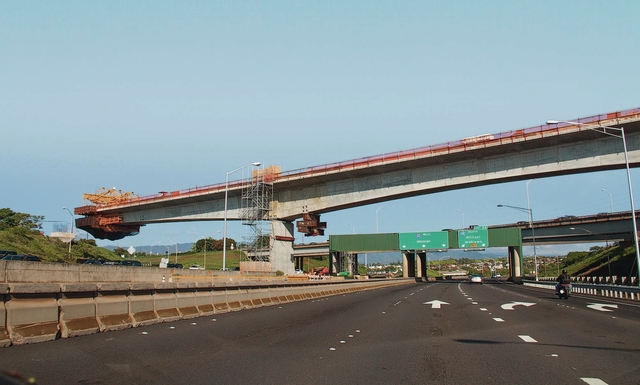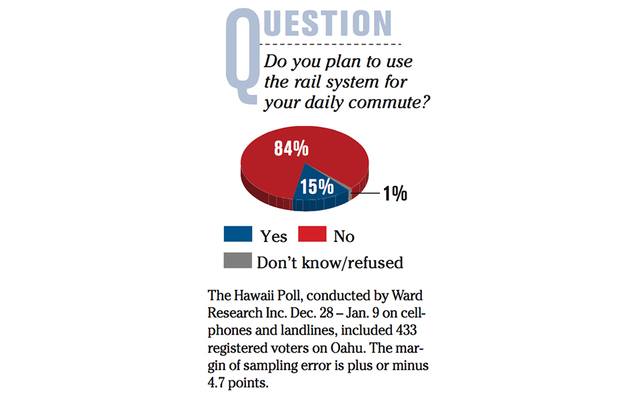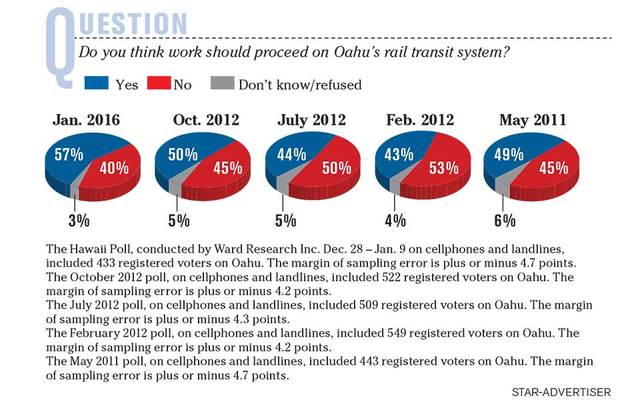With nearly 300 concrete columns planted firmly in the ground from East Kapolei through Central Oahu and nearly six miles of guideway built on top of them, most Oahu residents now say they think rail construction should proceed, the latest Hawaii Poll shows.
A majority of island residents — 57 percent — said they would prefer to see work on the 20-mile, 21-station system proceed, while 40 percent would like the rail work to stop, according to the survey by Ward Research Inc. for the Honolulu Star-Advertiser.
It’s the first time that a clear majority have said they would like to see rail work continue since Ward first asked that question in May 2011. The latest results come with rail construction in full swing and potentially severe financial consequences to reversing course now.
Meanwhile, the project’s costs have climbed by about $1.3 billion in the past year or so. The Hawaii Poll results on rail show that majority support to keep the work going will quickly erode if those costs keep climbing.
Currently, officials estimate rail will cost about $6.57 billion to complete, although no one yet knows what the final price tag will be. Only 41 percent of the Oahu residents surveyed for the poll said they would support ongoing work if rail’s price tag were to reach $8 billion. Then, only 30 percent of the total surveyed said they would support the project if it hits $10 billion. Finally, only 22 percent of the total surveyed said they would support it at $12 billion.
The Hawaii Poll, conducted Dec. 28-Jan. 9 on cellphones and landlines, included 433 registered voters on Oahu. The margin of sampling error is plus or minus 4.7 points.
“The general population, lay people, can we even grasp what a billion dollars is? … Where do you draw the line when it’s in billions? It’s really the psychology of it,” Ward Research President Rebecca Ward said Thursday. “If I’m somewhat in support, I might be fine with $6.57 billion. I might be fine with spending a little more. But I want to draw the line somewhere.”
The latest estimates from the Honolulu Authority for Rapid Transportation, which oversees rail construction, put the cost of completely stopping the project and tearing it down at nearly $2.5 billion. That includes the costs to repay the federal funds that the agency has drawn, pay off remaining contract obligations, deal with the claims from ending contracts early and tear down what’s already been built. It doesn’t include the more than $1.85 billion that’s already been spent on the project.
Some of those who participated in the poll called it a no-win situation, having to choose whether to proceed with a project with skyrocketing costs or stop and take such a tremendous financial hit.
“You know, my opinion is, what can we do? We’re already in motion. Either way we’re going to be losers,” Kaneohe resident Daniel Chong said in a follow-up interview Thursday. The Oahu native told pollsters that he was OK with proceeding at a cost of $8 billion but not $10 billion. “The price won’t stop growing until it’s done. I don’t know which way to go. If you stop you’re going to be a loser. If you go ahead you’re going to be a loser.”
Kapolei resident Bert Lee told pollsters he would support a $10 billion price tag but not a $12 billion tag.
“I’m OK because it got started, right? Once it got started it’s too expensive to knock down and stop a project,” Lee added Thursday. “I can’t fathom that, but at a certain time you got to cap it at $10 billion.” Lee said that he didn’t support the project prior to construction because he was wary of how fast it was being organized without a clear price tag or indication of how it might affect Oahu’s public bus system.
Some 15 percent of the Oahu residents surveyed said that they planned to use the rail system for their daily commute. Of those residents living from Aiea to Waianae, 24 percent said they would use rail for their daily commute.
In the January 2015 Hawaii Poll, more Oahu residents flagged rail as the most important issue facing the island, at 19 percent. In this year’s poll, rail came in second to homelessness, which 24 percent of those surveyed flagged as the most important issue. Rail got 16 percent this year.
Both issues could hamper Honolulu Mayor Kirk Caldwell’s re-election prospects this year, Ward said.
“To the extent that rail is impacting the mayor’s approval ratings, we don’t know,” she said. But both rail and homelessness are “causing erosion in the mayor’s popularity.”
Hawaii Poll — Rail Transit
The Hawaii Poll, conducted by Ward Research Inc. Dec. 28-Jan. 9 on cellphones and landlines, included 433 registered voters on Oahu. The margin of sampling error is plus or minus 4.7 points.
The October 2012 poll, on cellphones and landlines, included 522 registered voters on Oahu. The margin of sampling error is plus or minus 4.2 points.
The July 2012 poll, on cellphones and landlines, included 509 registered voters on Oahu. The margin of sampling error is plus or minus 4.3 points.
The February 2012 poll, on cellphones and landlines, included 549 registered voters on Oahu. The margin of sampling error is plus or minus 4.2 points.
The May 2011 poll, on cellphones and landlines, included 443 registered voters on Oahu. The margin of sampling error is plus or minus 4.7 points.








